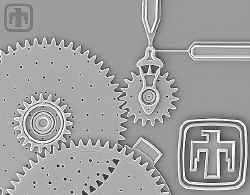Friction of Molecules

Engineers hope to make microscopic engines and gears as ordinary in our lives as microscopic circuits are today. But before this dream becomes a reality, they will have to deal with laws of friction that are very different from those that apply to ordinary-sized machines. In the 8 February PRL, a group of surface scientists has demonstrated that friction can arise between two surfaces even before they press against one another, through the formation of adhesions on the molecular level.
In classical physics, the amount of friction between two objects is proportional to the force that squeezes them together, called the “load.” This empirical observation, called Amonton’s Law after the 17th-century physicist who discovered it, works well for large objects, but “it really doesn’t work at the molecular level,” says Alan Burns of Sandia National Laboratories in Albuquerque, New Mexico. Two surfaces that are less than a nanometer apart can actually attract each other via molecular interactions, creating a paradoxical situation known as “negative load,” where the surfaces have to be pulled apart rather than squeezed together. 17th-century physics gives no guidance on how friction works in such a case.
In recent years, physicists have studied molecular friction with atomic force microscopes (AFMs), in which a scanning tip is pulled across a surface like an old-fashioned record needle. But, according to Burns, AFMs have one drawback: when the tip gets too close to the surface, the molecular forces make it jump into contact–thus passing right through the interesting negative-load regime. To overcome this problem, he and three colleagues designed an apparatus that carefully controlled the gap between the probe and the surface.
As a result, the researchers were able to study for the first time how friction varies with a negative load. The results depended strongly on the chemistry of the surface, a one-molecule-thick layer of alkanethiol lubricant attached to a gold film. This layer, Burns says, is like a “molecular brush,” consisting of long molecules that fasten to the gold at one end. Depending on the chemical makeup of the free end of the molecule, the hairs of the brush interact differently with a glass probe. When the “hairs” ended with a methyl group, the attraction was weak, and the amount of friction at negative loads was insignificant. But when the “hairs” ended with a carboxyl group, they formed hydrogen bonds with the probe and tugged strongly at it, creating measurable friction even at negative loads.
“This is a really fine experimental contribution,” says Jacqueline Krim, an atomic friction researcher at North Carolina State University in Raleigh. “The next step would be for someone to reproduce these results in a computer simulation,” so that theorists could tell whether their models accurately predict the friction observed by Burns’s experiment. In the long run, engineers of micromachines–machines on a computer chip–will also need to know how friction works at the atomic level. “Strong adhesion will prevent the gears from turning smoothly,” Burns says, “or prevent them from turning at all.”
–Dana Mackenzie
Dana Mackenzie is a freelance science writer.


